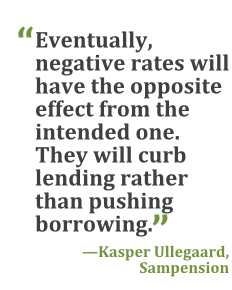When interest rates are high, people borrow less and save more. When they're low, savings go down and borrowing goes up. But what happens when rates stay negative?
In Denmark, where rates have been below zero longer than anywhere else on the planet, the private sector is saving more than it did when rates were positive (before 2012). Private investment is down and the economy is in a " low-growth crisis," to quote Handelsbanken. The latest inflation data show prices have stagnated.
 As the Danes head even further down their negative-rate tunnel, the experiences of the Scandinavian economy may provide a glimpse of what lies ahead for other countries choosing the lesser known side of zero.
As the Danes head even further down their negative-rate tunnel, the experiences of the Scandinavian economy may provide a glimpse of what lies ahead for other countries choosing the lesser known side of zero.
Recommended For You
Denmark has about US$600 billion in pension and investment savings. The people who help oversee those funds say the logic of cheap money fueling investment doesn't hold once rates drop below zero. That's because consumers and businesses interpret such extreme policy as a sign of crisis with no predictable outcome.
"Negative rates are counterproductive," said Kasper Ullegaard, head of fixed-income overseeing more than $15 billion at Sampension in Copenhagen. The policy "makes people save more to protect future purchasing power and even opt for less-risky assets because there's so little transparency on future returns and risks."
Macroeconomic Fallout from Currency Peg
The macro data bear out the theory. The Danish government estimates that investment in the private sector will be equivalent to 16.1 percent of gross domestic product this year, compared with 18.1 percent between 1990 and 2012. Meanwhile, the savings rate in the private sector will reach 26 percent of GDP this year, versus 21.3 percent in the roughly two decades until Danish rates went negative, Finance Ministry estimates show.
Denmark's central bank argues the policy has been successful because its sole mandate is to keep the krone pegged to the euro in a 2.25 percent band. The currency regime came under attack at the beginning of last year when Switzerland's failure to defend its euro cap fanned conjecture other central banks would also cave in to speculation.
The Danes prevailed, but only after cutting their benchmark deposit rate to minus 0.75 percent. Sales of Denmark's AAA-rated government bonds were halted and currency reserves were quickly built up to almost 40 percent of GDP. The measures saved Denmark's euro peg, allowing central bank Governor Lars Rohde to declare victory.
But while the currency regime was upheld, the macroeconomic fallout provides little reason for celebration. There are few signs the extreme monetary stimulus is aiding growth, and the government last week slashed its GDP forecast for this year to 1.1 percent, from the 1.9 percent previously seen. March inflation data showed annual prices completely stagnated after about two years of readings well below 1 percent.
Carsten Stendevad, the chief executive officer of Danish pension fund ATP, with about $115 billion in assets, says the policy is also proving problematic for markets.
"I'm very concerned about what these low, negative rates mean," Stendevad said. "I'm concerned about what they mean for asset pricing. Clearly, they are driving asset prices. That's the intention, but it's always a cause for concern when asset pricing is driven more by central bank policy than cash flow generation."
The fund is positioned for a return of inflation, not necessarily imminently but at some point. Back in February, Stendevad noted that it would be an "anomaly" if very low interest rates didn't result in "high inflation at some point."
Banking Reaction to Negative Rates
The only bright spot seems to be the success with which Denmark's banks have withstood negative rates. Danske Bank A/S, the country's largest lender, reported its biggest profit on record in 2015. Its first-quarter results exceeded analyst estimates in part as the bank wrote back impaired loans that Danes found easier to repay amid record-low rates.
The bank's CEO, Thomas Borgen, says Danske is "preparing for these low rates for a prolonged period of time." Most economists tracking Denmark don't see a shift into positive rates until 2018 at the earliest.
Danske, like other banks trying to hold on to customers while operating in negative-rate environments, has so far promised retail clients they won't be asked to absorb the cost of the policy via their deposits.
To make up for lost lending income, Danske and other Nordic banks are focusing more on investing the savings of wealthy Scandinavians in an effort to earn more fees. And with stricter capital requirements making traditional lending more costly, banking in the region may shift more toward wealth administration in the future.
Given the long-term outlook of extremely low rates, Ullegaard at Sampension says the upshot looks clear.
"Eventually, negative rates will have the opposite effect from the intended one," he said. "They will curb lending rather than pushing borrowing."
© Touchpoint Markets, All Rights Reserved. Request academic re-use from www.copyright.com. All other uses, submit a request to [email protected]. For more inforrmation visit Asset & Logo Licensing.



